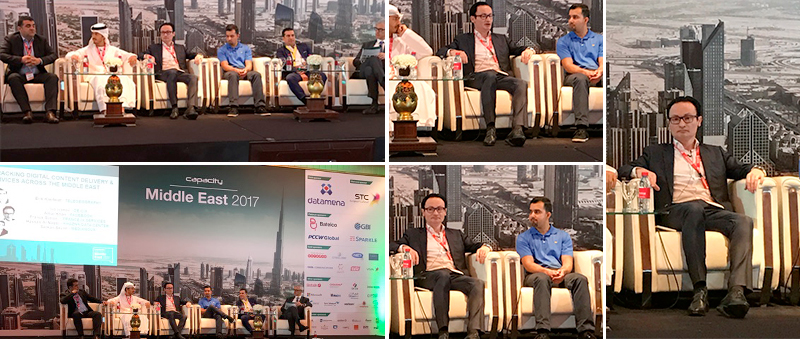Zoom on Capacity Middle East 2017
In March, I was invited to speak as part of a panel at the Capacity Middle East conference in Dubai. Now in its 13th year, Capacity Middle East is the largest gathering of Tier 1, Tier 2 and Tier 3 carriers and service providers in the Middle East.
The panel in question was called: Fast-Tracking Digital Content Delivery & services Across the Middle East. With a senior analyst from Telegeography, Erik Kreifeldt, as moderator, the various panellists who included Ivo Ivanov, CSO of DE-CIX; Amar Khan, Network Strategy at Facebook; Hassan Al Naqbi, CEO of Khazna Data Center and Serkan Sevim, CEO of Medianova looked forward to a lively debate.
There was much discussion but the question that intrigued me the most was: Why is most Middle East traffic exchanged in Europe? Should that change? Why and How? What are the prospects for more regional interconnectivity?
A look at the current situation in Europe and in the Middle East helps to answer these questions. It is true that although content from content delivery networks (CDNs) is already effectively being delivered in some parts of the Middle East, in Dubai for example, some carriers have chosen to not peer locally in the Middle East for the time being. The reasons why local peering is not as developed as it could be, are that firstly, carriers find the cost of the last mile connectivity to be prohibitive and secondly, there are still some perceived legal and political issues in the region.

The result is that carriers are instead choosing to peer in Europe most of the time and we see this trend at France-IX Marseille as well. Although geographically it is further away from content consumers living in the Middle East, Marseille offers a better peering ROI in a fully deregulated environment. Add to this the fact that from a technical point-of-view, the submarine cables between Marseille and the Middle East landing points deliver a quality of service as good as one delivered from a locally-based CDN, and the choice of Marseille starts to make sense.
The economic benefits of peering in Marseille can be attributed in part to the revolution provided by the latest submarine cables landing in Marseille: SEA-ME-WE-5, ready for service since December 2016 and AAE-1, scheduled for Q2 2017. With the introduction of the latest 100G DWDM optical technology, these new cables support much more capacity than the previous submarine cables at a declining cost per unit, which enables the consortium owners to offer more competitive and attractive bandwidth pricing. SEA-ME-WE-5 cable history illustrates perfectly this evolution: SEA-ME-WE-4, commissioned in November 2005, was designed to offer 64x2x10 Gbps of capacity for a total investment of US$ 500M, whereas SEA-ME-WE-5 commissioned in December 2016 provides its members with 24 Tbps of capacity for a total investment of US$ 700M.
Last but not least, established by industry leading carriers with extensive experience in the submarine cable projects, the latest cables have been designed to be open systems with free access to carrier neutral and international Points of Presence, like Interxion Marseille Data Centers. This means that the cost of the fully protected terrestrial extensions rom the landing station to the selected carrier-neutral international Data Center in Marseille is transparently factored into the international connectivity cost, unlike in the Middle East, where is it an expensive add-on.
This explains why you find a high concentration of worldwide CDNs such as the likes of Akamai, Amazon CloudFront, Microsoft Azure CDN, Cloudflare, Limelight Networks and OVH at France-IX Marseille, not to mention the carriers’ CDNs with presence in Marseille as well. Marseille offers them the perfect gateway not only to deliver content in the Middle East market but also to reach the rising African market.
In the short term, due to economics, last mile issues, political and legal situations, the Middle East’s loss is, for now, Marseille’s gain. In the long term, we want and expect peering in the Middle East to thrive like it should be and for Marseille to offer the lowest latency, diverse and resilient option for reaching networks in the European and African continents.